A Creative Collaboration: R. J. Lloyd and Ted Hughes
(My thanks to R. J. Lloyd, Louise Lloyd, Carol Hughes and Frances McDowall).© Ann Skea.
In the years between 1959 and his death in 1998, Ted explored and experimented with many different ways of publishing his poetry and his desire to find an inexpensive, reliable way of making poetry easily available to everyone never diminished. In the course of his experimentation, he collaborated with a number of artists and publishers to produce broadsides, posters, books, and pamphlets in limited editions. Some of these collaborations, like that with his long-time friend, Leonard Baskin, are well-known and well documented. Others, like his equally successful work with R. J. Lloyd between 1970 and 1994 are not.
Reg Lloyd is primarily a painter but he works in many media, including stained-glass, pottery and printmaking. He and Ted first met through a mutual friend and they first found common ground in childhood memories of a shop bell ringing: Reg’s parents had owned a drapers shop and Ted’s parents had been newsagents. From this slight beginning they discovered that they shared other interests and their friendship developed. Then, some time in the mid-sixties, a suggestion was made that they should work together to produce posters and broadsides. Reg had already started work on some silk-screen prints and they both liked the idea, so, their collaboration began.
Ted gave Reg four poems: ‘King of Carrion’, ‘That Moment’, ‘Crow’s Last Stand’ and ‘Crow and the Birds’, and Reg recalls that he “printed the text on an old Hercules poster press using wooden typeface, then added the silkscreen decorations. These were produced in a very limited edition of twenty copies of each, which were subsequently included in my exhibition of silkscreen prints and monotypes at the Irving Galley, Bideford, in August 19701”. Poems by Ted Hughes and John Moat were included in this exhibition and the exhibition catalogue noted that the poets provided “themes for some of the suites” of prints, “adding a deeper dimension of meaning”. It went on to say that Reg’s prints were “not illustrations of the poetry but, rather, extensions of the mood evoked by the words – a partnership of word and image”2.
“Time went on with mutual visits”, writes Reg. “Ted would bring his latest works and I became bold enough to suggest that Baskin’s work was too much akin to Ted’s, to which he agreed and, indeed, wrote in the copy of Cave Birds which he gave me 'A cockfight in poetry'”. But it was Carol Hughes who first suggested that Reg should look at the manuscript of What is the Truth? with a view to illustrating it. “I looked”, says Reg, “and decided to have a go. Sent some specimens to Fabers and they commissioned me to carry on. I’m not sure what the contract arrangements were at the time but there didn’t seem to be any limitations as to how many illustrations there were to be. So Fabers sent me the galleys.... All that was decided was the format, so I chopped up the galleys and reassembled them to fit around my illustrations”.
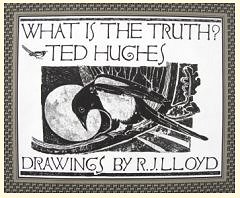
Reg designed and illustrated the whole book and on the cover, knowing of Ted’s superstitions and that Ted would remember the old rhyme ‘One for Sorrow, Two for Joy...’, he added a tiny extra magpie to his drawing. Ted also asked him to include a wren somewhere in the book. Although the Jenny Wren is only briefly mentioned in the text, the wren is an important bird in English mythology, a sacred oracle bird, King of the birds and representative of the fertile energies of nature. Ted described it vividly in Adam and the Sacred Nine3, where it is one of the ‘angelic powers’ which visit Adam to awaken him to spiritual life4. So Reg provided two wrens. One appears opposite the page associated with the Christmas Goose and the two muddy-footed goose “queens”, the other at the end of the book amongst all the ‘holy’ animals5.
What is the Truth?, which was published by Faber in 1984, was marketed as a children’s book and won the Guardian’s Children’s Fiction award for that year. It was dedicated to Clare and Michael Morpurgo, friends and Devon farming neighbours of Ted’s who had first suggested the project to him6. Written in poetry and prose, it is a fable in which the spirits of a sleeping “Farmer, his Wife, and Son and Daughter, the Vicar, the Poacher, the Schoolmaster and the Shepherd” each describe the different animals around them. Each description is a version of the truth about that animal, and each version reflects the speaker’s own experience of the world. So, for example, the Farmer’s wife describes the cow as a motherly creature, the Farmer sees cows as hard work, and their daughter sees only their gentle beauty. Each, as Ted wrote in 1989, “has his/her own idea of what any particular creature is, but none of them know that each one is actually God”7.
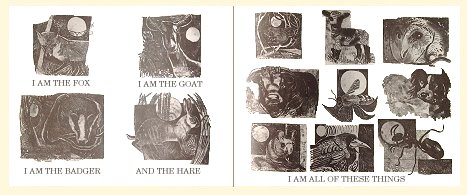
Writing to Baskin in November 1983, Ted called this book “my poems about animals for the infantile”8. He went on to say, only half ironically: “Every bard speaks for a tribe – mine is the Universal infantile, a mighty people”. There are echoes here of the words of Ted’s protagonist in Cave Birds, who claims to be “Imbecile Innocent”9; and of the people in Remains of Elmet whose “everlasting play”10 brought ruin to them and their enterprises. The importance of this fable to Ted and his special meaning of both ‘infantile’ and ‘imbecile innocent’ is clear in the explanation of What Is The Truth? which he provided for teachers in the Poetry Book Society’s leaflet, Classroom Choice11. His people, as he pointed out, are literally asleep but they are also spiritually unawakened: their versions of the Truth, therefore, are only partial. The real truth, revealed in the words of God at the end of the book, is the Blakean truth that everything that lives is holy: “I am each of these things....And each of these things is me”. And Reg Lloyd’s black and white illustrations convey the true beauty of even the most humble and the most maligned of creatures, such as the worm, the mosquito, the flea and the fly.
Ted’s original idea for the book had been a more complicated story of the way in which God’s Son learns about man’s oppression of “the creatures he loves best”. He described it in a letter to Nick Gammage in 1998 but went on to say that because the book was intended for Farms for City Children, in writing the poems he “relaxed this scheme....simply let the creatures blossom and obscured the first theme with another”. So, the fable which he “floated” as “a carrier wave for transmission about creatures on a farm” became one about “the true divinity of creatures and man’s inability to see that truth” 12.
In his letter to Baskin, Ted wrote that the book was “really charming, richly illustrated” and that Reg had done a “lovely job...Far and away his best work, I think”. Years later, in an introduction which Ted wrote for a retrospective exhibition of Reg’s work at the Hereford City Museum and Art Gallery in 1996, the importance of Reg’s illustrations as part of Ted’s vision is clearer: “These were black and white drawings, but it struck me at the time, there is hardly a plate in the book without its heavenly light – a moon or sun. Even the worms, in one of the best, seem to be worshipping the rising sun. One way or another, he has made each of these creatures a sacred figure”13.
Sadly, in the later Faber publications Collected Animal Poems (1995); Ted Hughes: Collected Poems (2003); and Ted Hughes: Collected Poems for Children (2005), the poems appear without the connecting story and without Reg Lloyd’s illustrations14.
After What Is The Truth?, Reg suggested to Ted that they do another “small richly-coloured book about familiar creatures” and publish it themselves. Ted spoke to me of this as their “naughty adventure” outside the Faber fold15; and Reg writes that they “decided to go it alone (much to Fabers’ annoyance) under their own imprint ‘The Sunstone Press’. Ted simply wrote out a possible list of subjects and I went away and did my paintings and Ted did his poems. The results were quite uncanny sometimes, as though some mysterious cross fertilisation had taken place”.
The result of this venture was The Cat and the Cuckoo, which they published in 1987 as a limited edition of 2,000 books, 250 of which were numbered and signed by both artist and poet. In addition, a series of 28 separate sheets was published, each reproducing one of Reg’s paintings and the accompanying poem by Ted. Reg designed and illustrated the book. He also designed the Sunstone Press imprint, and the advertising flyer which contained small images of all 28 of the paintings and, like the cover of the book, featured Reg’s picture of the Lloyd family cat, Tim. The first printing of Ted’s poem ‘Cat’ appeared on the back of the flyer.
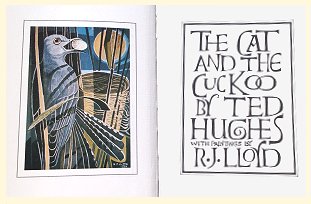
Reg’s prints were exhibited at Senate House in London, Exeter University and the Barnstaple Library, Sterts Arts centre in Cornwall and a number of National Trust houses, and order forms and prints were made available at each. Originally Ted and Reg had planned to produce four books in The Cat and the Cuckoo format so that they could be boxed together but production and distribution proved to be more difficult and more expensive than anticipated. Eventually, they took up the offer of a new printing of 2,000 copies of The Cat and the Cuckoo for “a bargain price”, but were unable to sell them. “We had to go cap-in-hand to Fabers and get them to take it on”, Ted told me: and Fabers “spoiled the plan”16. In a letter to Keith Sagar in October 1993, Ted wrote: “Faber had about 2,000 Cats and Cuckoos for two years and never sold one. Eventually Reg and I took them back. He’s selling his in fifties to art galleries, National Trust shops etc.”17. Reg cannot recall selling the book in fifties to galleries, but he did give them away to schools or children’s charities and, at the time of writing his memoir (2009), he still had some for sale.
In his letter to Nick Gammage in 1998, Ted wrote that after writing about the animals in What is the Truth?, “eventually I tried again, with "The Cat and the Cuckoo"....Mainly, I wanted to write pieces that would make it easier (even easier?) for readers - urban readers - to like these creatures. Or to share my liking. Or to make something pleasurable out of describing my liking”18. An important part of the dedication in The Cat and the Cuckoo is to “all the children who visit FARMS FOR CITY CHILDREN”19.
The next book on which Ted and Reg collaborated was The Mermaid’s Purse. Again, this book was to be their own Sunstone Press publication; and again Ted wrote a list of possible subjects20, then Reg did his paintings and Ted wrote the poems. Reg chose the title and painted an image of a Mermaid's Purse for the label on the slip-cover of the book.
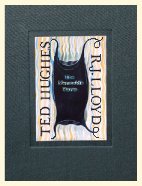 A Mermaid's Purse (sometimes also know as a Devil's Purse) is the collagenous egg-case which surrounds the fertilized eggs of some sharks, dolphins, skate, and an ancient order of fish known as 'Chimera'.
The empty cases are frequently washed up on beaches, and the title was apt for this new book which was to be all about things which are found in or by the sea. Reg writes that, as with The Cat and the Cuckoo, “the results of our non-co-operation, if I may call it that, were quite amazing, especially the wreck poem and picture. Ted, Danny Weissbort and myself had walked to Hartland Cliffs where the ship 'Johanna' had come ashore and was now well rusted. The twisted metal plates standing on end suggested some sort of growth – have a look again at the poem”21.
A Mermaid's Purse (sometimes also know as a Devil's Purse) is the collagenous egg-case which surrounds the fertilized eggs of some sharks, dolphins, skate, and an ancient order of fish known as 'Chimera'.
The empty cases are frequently washed up on beaches, and the title was apt for this new book which was to be all about things which are found in or by the sea. Reg writes that, as with The Cat and the Cuckoo, “the results of our non-co-operation, if I may call it that, were quite amazing, especially the wreck poem and picture. Ted, Danny Weissbort and myself had walked to Hartland Cliffs where the ship 'Johanna' had come ashore and was now well rusted. The twisted metal plates standing on end suggested some sort of growth – have a look again at the poem”21.
Like their two earlier books, The Mermaid’s Purse was originally intended to be for children, but Reg had come to see that these books were rather like small catalogues for his own, larger, art works, so he deliberately made the illustrations for this book more ‘adult’ and closer to his normal style. Ted, too, did not believe that children’s poetry should be childish, but he found The Mermaid’s Purse poems more difficult to write than those for The Cat and the Cuckoo. “It’s hard to write a quantity of poems about sea-creatures”, he told me, “Some of them are so cold and prickly for children”. Reg, too, according to Ted, found them “chilly”22, but his illustrations are beautiful and many of them include the ‘heavenly light’ which had so struck Ted in the plates for What is the Truth?.
They had more success with The Mermaid’s Purse, which was published in May 1993. The Independent newspaper chose it as their 'Book of the Week' and the whole edition of 100 books was sold within twenty-four hours.
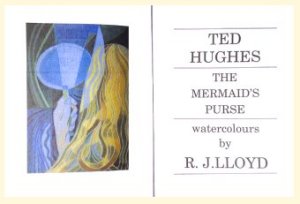 However, the planned boxed set of four volumes of books for children was never produced.
However, the planned boxed set of four volumes of books for children was never produced.
Faber and Faber offered to take on The Mermaid’s Purse for publication as a trade edition but, Ted said, they wanted to publish it with a different artist’s illustrations or to be paid to use Reg’s. So they never took up this offer23.
Ted’s and Reg’s next collaborative book, Earth Dances, came about after Nicolas and Frances McDowall of The Old Stile Press suggested to Reg that he illustrate a book for them with text from various different authors on the subject of stones and stone circles. They made suggestions for the text which “did not set him on fire”, so Reg asked Ted if he could make his own selection of Ted’s poems and illustrate them. Ted agreed, and The Old Stile Press “jumped at the idea”.
Earth Dances is a book about the land. Reg writes that he “enjoyed making the selection [of poems], Ted didn’t interfere in any way”. He then cut the lino blocks for his pictures, and Nicolas McDowall printed them,24 and designed and printed the book. As for The Mermaid’s Purse, Reg’s pictures were more sophisticated than those for What is the Truth? and The Cat and the Cuckoo. An Old Stile Press advertisement describes them as “wonderfully decorative lino-cut images, some of which take full pages while others are interwoven with poems on the text pages”. It goes on to say: “Ted Hughes also wrote a new poem, ‘Epigraph’25 for his friend R.J. Lloyd and especially for inclusion in this book. It evokes the wild moorland country which has so often inspired both poet and painter in their work”26.
As with many fine-art, limited edition books, each production involved poet, artist, printers, binders and papermakers. The paper on which the books were printed was always carefully chosen and Reg comments that “the "Mermaid’s Purse" would have been better printed on harder paper. The illustrations are not at their best”. The paper for Earth Dances was especially interesting. The Old Stile Press Bibliography notes that eight of the nine illustrations were printed on four different papers made by Frances McDowall and these incorporated iris, nettle, onion, Japanese knotweed, pampas grass and alkanet fibres. In a talk about papermaking which Frances gave in 2007, she describes how Reg “had seen some of the papers I was making and wanted to use some made from different plants for his images for some of Ted Hughes nature poems. This was an exciting project - however, it would require 10 sheets for each of 250 copies of Earth Dances. So I selected plants, cooked them, ‘beat’ them in a couple of domestic liquidisers together with an old butter churn redundant from N’s parents' farm (which bashed rather than cutting the fibres). The plant fibres were mixed with some offcuts from papers already used in the press (so of good cotton fibres). It is a project such as this that pushes one over that barrier between an amateur and a committed craftsperson”27.
Earth Dances was published in December 1994. After that, Reg says “Ted and I talked about future books, one to be entitled 'Rubbish', and we were exploring the possibility of 'Gawain and the Green Knight'. The latter appealed to me greatly. With the 'Rubbish' book, I had already started to make notes. Oh well, it was not to be”.
Ted’s collaboration and friendship with Reg Lloyd was clearly a mutually satisfying experience. Reg remembers Ted as a kind and generous friend: and Ted clearly admired Reg’s art and saw in it the same “root-system” running “back into the land itself, and into the cyclic natural world”28 as inspired his own creations. “There were long periods when, because of our various commitments, we did not see each other”, Reg writes, but Ted “would always sing 'Happy Birthday' over the phone on the 21st December. My birthday always intrigued Ted being the winter solstice”.
Clearly, throughout Ted’s life there were artistic collaborations which he found satisfying and inspiring. In spite of this, Ted amazed me on two separate occasions by saying that he did not like poetry and pictures published together. This was not just because artists tended to think that their work would be ignored or regarded simply as illustrations to Ted’s poems, but because Ted himself often thought the opposite was true. Fay Godwin recalled that Ted wanted his poem printed larger than was originally planned for their Elmet books, so that they were not “swamped by the photographs”29.
Ted’s concern, however, was based on his own reading and understanding of the way in which the human brain works. Words and pictures, he told me, “are processed by different parts of the brain and this causes conflict in the reader, and upsets his or her concentration”. Research, too, he said, suggests that image is dominant, and poetry, when it is only seen on the page, is processed by a part of the brain which is disconnected from the visceral auditory part of the brain - the most primitive part which controls the harmony of the whole body. For this reason, Ted believed that poetry should always be read aloud30.
Given the number and frequency of Ted’s artistic collaborations and the way in which the art and poetry in these works generally complement and illuminate each other, Ted’s reservations about poetry and pictures appearing together were surprising. However, he also told me that he did enjoy responding to art work and that was why his limited editions were always illustrated and why, as with the Morrigu Press publications, he even did some of the illustrations himself.
With trade editions of his work Ted had no choice. Publishers, he said, were of the view that children’s books, in particular, would only sell if they were illustrated and, as with The Mermaid’s Purse and Earth Dances, they had very definite ideas about what sort of illustrations would be suitable. Fortunately, he was generally pleased with the work of the artists the publishers chose.
In the years between 1969 and his death in 1998, Ted explored and experimented with many different ways of publishing his poetry31. Full descriptions of his collaborative, limited edition publications, which include work with many different artists and small Presses32, can be found in Sagar.K, and Tabor, S. Ted Hughes: A Bibliography 1946-1995, Mansell, 1998.
REFERENCES AND NOTES
1. R. J. Lloyd and Ted Hughes. Unpublished memoir enclosed with an e-mail from Reg Lloyd to Ann Skea, 25 Nov. 2009.
2. Catalogue for New Prints by R.J. Lloyd with Poems by Ted Hughes and John Moat. 26 Aug. - 12 Sept. 1970. At the Irving Gallery, 21 Bridgeland St. Bideford 4270.
3. ‘The Unknown Wren’, Hughes, T. Adam and the Sacred Nine, Rainbow Press, 1979: Keegan, P. (Ed.), Ted Hughes: Collected Poems, Faber, 2003. pp. 447-8.
4. See my online discussion of Adam and the Sacred Nine as a cabbalistic drama : .//AdamHome.html
5. Hughes, T. What is the Truth?, Faber, 1984. pp. 85, 125.
6. Michael Morpurgo is the well-known author of children’s books. In 1974 he and his wife Clare founded the charity Farms for City Children. Ted was the first President of this charity . Michael Morpurgo talks about the farms.
7. Reid, C. (Ed) Letters of Ted Hughes, Faber, 2007. Hughes to Gammage. 29 Nov. 1989. pp. 571-2.
8. Hughes/ Baskin correspondence, 9. Nov. 1983. British Library. Add. mss. 83684-83698.
9. ‘In these fading moments...’, Keegan,P. (Ed.), op.cit. p.423.
10. Ibid. ‘Tick Tock Tick Tock’, p.490.
11. Hughes, T. 'What Is The Truth? And the Collected Animal Poems’, Classroom Choice, Issue 2, Poetry Book Society, Autumn 1995.
12. Hughes to Gammage, 29 Nov. 1989, in Reid, C. (Ed), op.cit. pp. 571-2.
13. Hughes, T. ‘Preface’. R.J.Lloyd: A Retrospective Exhibition of Selected Works, Hereford City Museum and Art Gallery, 1996. pp.vi-vii.
14. Ted made the selection for Collected Animal Poems in 1995 and the posthumously published collections simply followed Ted’s lead. The illustrations, the box and the covers were chosen by the Estate and by Faber & Faber. Letter from Carol Hughes to Ann Skea, 31 March 2012.
15. Skea, A. Notebooks and diaries, 1992. British Library, Add MS 88978/1: Ann Skea Notebooks: 9 Oct 1992-Jan 1999.
16. Ibid.
17. Sagar, K. (Ed.) Poet and Critic: The Letters of Ted Hughes and Keith Sagar, The British Library, 2012. p. 236.
18. Reid. C. (Ed.), op.cit. p.572.
19. The book is also dedicated to Daniel Hews [sic.], Sebastian Clarke, and Hugh and Toby Norton-Smith.
20. Ted’s original list of 30 subjects survives and includes "Bladderwrack", "Shrimp", "Thrift", "Sandflea", "Stranded Whale" and "High Tide Rubbish". Scribbled on the same sheet are a couple of brief off-the-cuff rhymes, one about an otter, one about Louise and Reg Lloyd.
21. ‘Wreck’, Ted Hughes Collected Poems for Children, Faber, 2005, p.7. The drawings in this book are by Raymond Briggs and are nothing like Reg Lloyd’s evocative paintings in The Mermaid’s Purse.
22. Skea, A. Notebooks and diaries. 24 Aug. 1993. British Library. op.cit.
23. Skea, A. Notebooks and diaries, Oct. 1992. British Library, op.cit. Faber did publish The Mermaid’s Purse in 1999 (after Ted’s death) with illustrations by Flora McDowell.
24. Louise Lloyd writes that “Reg had the lino cuts printed separately which he sold in sets after the book had sold out”.
25. Keegan, P. (Ed.). op.cit. p. 852.
26. The Old Stile Press.
27. McDowall, F. Transcript of a talk given to the IAPA at Wadham College, Oxford, 2007. A talk by Frances about her paper making. This article also contains an image of the title pages of Earth Dances which include one of Reg’s lino-cut images.
28. Hughes, T. ‘Preface’. op cit. p.iv.
29. Gifford. T. ‘Interview with Fay Godwin: transcript’, Thumbscrew 18, Spring 2001.
30. In a letter to Daniel Huws in April 1957, Ted explained this view more fully. Reid, C. (Ed.), op.cit. pp.96-7.
31. Reg Lloyd has a poem written by Ted on a table napkin – a means of circulating poetry which Ted once suggested to Daniel Weissbort.
32. Ted is listed among the founders and directors of The Rougemount Press (1970-1974), Exeter, together with Eric Cleave, Moelwyn Merchant and Paul Merchant. Ted wrote introductions to two of their publications: Fiesta Melons by Sylvia Plath and Stones: poems by Paul Merchant.